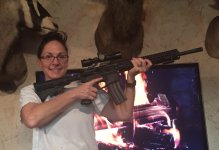k0ua
Epic Contributor
Anecdotal comment on firearm training. I have had both military and civilian training and in 40+ years have fired thousands of rounds for many platforms. The day before Christmas my son and I went to the local indoor range and while shooting heavy .357 magnum loads in a revolver I had my first squib fire. It is very loud at this range and both my son and I were wearing both plugs and muffs so no recoil was the first indication and I assumed a hang-fire had occurred. After waiting a couple minutes I was going to clear the handgun, reload and resume firing but something didn’t feel right. On further inspection we found a bullet was indeed lodged in the barrel and I shudder to think what could have happened had we continued shooting.
Thinking back on all the training I have had, I believe more emphasis should be placed on recognizing and dealing with dry, hang and squib fires. With today’s tacticool mentality and the tap, rack and bang training it would be so easy to discharge another round with possibly devastating results. Shoot safely and keep them in the 10-ring!
In IPSC/USPSA competition shooting, it is stressed by the simple to remember little phrase. "if it goes pop, you STOP". Yes a squib can be a very dangerous event. It is usually caused by a round with a bullet, and a primer but no powder in it. The primer drives the bullet from the case and partially into the barrel. Sometimes not far enough up the barrel to allow another round to be chambered, sometimes in a revolver it lodges in the forcing cone and does not allow the cylinder to turn or even to be opened, but sometimes far enough up the spout to allow another round to be fired behind it with disastrous high pressure results. usually resulting in a bulged (ringed) barrel, or even a (rarely) possibly burst barrel.

